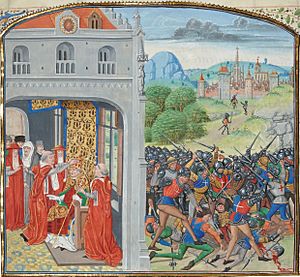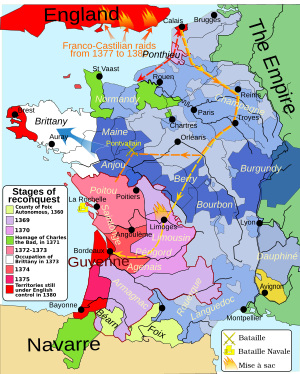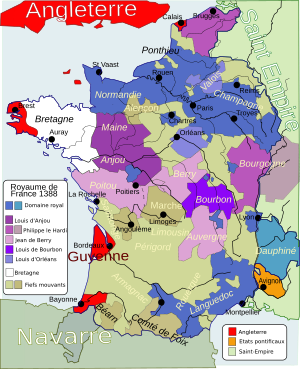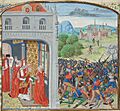Hundred Years' War, 1369–1389 facts for kids
Quick facts for kids Caroline War (1369–1389) |
||||||||
|---|---|---|---|---|---|---|---|---|
| Part of the Hundred Years' War | ||||||||
 The Battle of Pontvallain |
||||||||
|
||||||||
| Belligerents | ||||||||
|
|
|
|||||||
| Commanders and leaders | ||||||||
|
|
|
|
||||||
The Caroline War was the second part of the Hundred Years' War. This long conflict was fought between the French and the English. It started after the first part, called the Edwardian War. The war was named after Charles V of France, who was the French king at the time. He restarted the fighting nine years after a peace treaty was signed in 1360. During this phase, France was much stronger and won most of the battles.
The Black Prince was the oldest son of Edward III of England. He spent a lot of money to help Peter the Cruel become king of Castile again. But Peter could not pay him back. So, the Black Prince decided to raise taxes in his lands in Aquitaine, France. The people there complained, but no one listened. They then asked the French King Charles V for help. In May 1369, King Charles V told the Black Prince to come to Paris. The prince refused, and Charles V declared war. He wanted to win back the lands France had lost in the earlier peace treaty. He was very successful during his lifetime. His son, Charles VI, later made peace with the Black Prince's son, Richard II, in 1389. This peace lasted for many years until the war started again in 1415.
Contents
Why the War Started Again
The Treaty of Brétigny was signed in 1360. In this treaty, Edward III of England gave up his claim to the French throne. In return, he received the region of Aquitaine as his own land. For nine years, there was official peace between England and France. However, English and French forces still fought in other places like Brittany and Castile.
Fighting in Brittany
In the War of the Breton Succession, England supported one side, and France supported the other. The English-backed leader, John of Montfort, won a key battle in 1364. He defeated and killed the French-backed leader. Even though England won, they didn't gain much. John of Montfort had to accept the French king as his ruler. However, France gained a very skilled general, Bertrand du Guesclin. He left Brittany to serve King Charles V of France.
Trouble in Castile
After peace came to France, many soldiers had no jobs. They started to rob and cause trouble. King Charles V also wanted to get back at Pedro the Cruel, the King of Castile. Pedro had married Charles's sister-in-law and then had her poisoned. So, Charles V sent Du Guesclin to Castile to remove Pedro from power. This led to the Castilian Civil War. Du Guesclin succeeded, and Henry of Trastámara became the new King of Castile.
Pedro asked the Black Prince for help, promising him rewards. The Black Prince helped Pedro become king again after a battle. But Pedro refused to pay the English and their allies. Without their support, Pedro lost his throne again and was killed. England gained nothing from helping Pedro. Instead, the new King of Castile became an enemy and allied with France. Castilian ships then attacked the southern coasts of England. This helped France greatly in the Hundred Years' War.
New Taxes and French Claims
The Black Prince spent a lot of money helping Pedro in Castile. He did not get paid back, so his treasury was empty. To get his money back, he raised taxes in Aquitaine. The people of Aquitaine, called Gascons, were not used to such high taxes. They complained to the Black Prince, but he did not listen. So, they turned to the King of France, Charles V, for help.
Under the Treaty of Brétigny, the King of France had given up his power over Aquitaine. But after thinking about it, it was decided that King Edward III's giving up of France was not complete. This meant the King of France still had some power over Aquitaine. So, Charles V ordered the Black Prince to answer the complaints of his people. Edward refused, and this started the Caroline War.
France Fights Back
When King Charles V restarted the war, France was in a stronger position. It was the largest and most powerful country in Western Europe. England had also lost some of its best military leaders. King Edward III was too old to lead, and the Black Prince was very sick. In 1370, John Chandos, a very experienced English leader, was killed.
Following the advice of Bertrand du Guesclin, who became France's top general, the French used a new plan. Instead of fighting big battles, they slowly wore down the English. They took back lands that England had gained in the earlier treaty, piece by piece. This included the important city of Poitiers in 1372.
In August 1372, the English suffered a terrible defeat at sea near La Rochelle. A fleet from Castile attacked and sank English ships carrying supplies and money for their troops. This defeat left the English coast open to attacks from French and Spanish ships. It also cut off Gascony from England. This made many people in England unhappy about the war. An important Gascon leader fighting for England, Jean III de Grailly, Captal de Buch, was captured. King Charles V refused to release him, saying he was too dangerous. He died in prison in 1376.
English Raids and French Defense
The English tried to fight back with destructive raids into French lands. These raids were called chevauchées. They hoped to force Du Guesclin into a big battle. The most famous raid was led by John of Gaunt in 1373. This raid happened between two outbreaks of the Black Death. The plague made it hard for John of Gaunt to pay for his army.
The English planned to march over 1,000 miles, burning villages and farms. They wanted to destroy France's ability to collect taxes. They also wanted to show that King Charles V could not protect his people. But Charles V told his farmers to hide in fortified towns. He also ordered his army to avoid big battles. As the English marched, a French general, Olivier de Clisson, followed them. He killed many English soldiers and took prisoners. The English lost most of their supplies crossing rivers in October.
By the time they reached Bordeaux in December 1373, many English soldiers were sick and starving. This defeat made many people in England angry at John of Gaunt. By 1374, the peace treaty of Brétigny was no longer followed. England held very little land in France, except for Calais.
Peace Talks and New Rulers
In 1375, Pope Gregory XI helped arrange a peace treaty called the Treaty of Bruges. It set up a 12-month truce so both sides could talk about ending the war. France was represented by Philip II, Duke of Burgundy, and England by John of Gaunt. The talks failed because England wanted full control over Aquitaine, but France refused. The war started again in 1377.
The Black Prince died in 1376. In 1377, King Edward III of England also died. His ten-year-old grandson, Richard II, became the new king. The war continued until 1389, when a series of truces (peace agreements) were signed.
King Charles V of France died in 1380. His young son, Charles VI, became king. He was too young to rule, so his three uncles ruled for him. Charles V had stopped royal taxes before he died. When his uncles tried to bring back the taxes, people revolted. This revolt was called the Harelle and started in Rouen. It spread to other French cities. The rulers had to cancel the taxes to calm the situation.
The Great Schism
In 1378, King Charles V supported a new pope in Avignon, France. This started a big split in the Church called the Western Schism. For almost 40 years, there were two or even three popes, each claiming to be the true leader. This made it harder to end the Hundred Years' War. The popes tried to arrange peace talks, but they were not powerful enough to force an end to the fighting.
Images for kids




